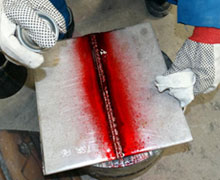Liquid Penetrant Testing (PT):
 The test object is coated with a special solution that contains a visible (or fluorescent) dye with good penetrating ability. Excess solution is then removed from the surface of the object but leaving it in surface breaking defects. A developer, which also acts as a white contrast background, is then applied to draw the penetrant out of the defects. With fluorescent dyes, the technique differs in the sense that no developer is required as ultraviolet light is used to make the bleed-out fluoresce brightly, thus allowing imperfections to be readily seen. With visible dyes, vivid color contrasts between the penetrant and developer make "bleed-out" easy to see. The red indications in the picture above represent a number of defects in this component that lie deep within but are open on the surface, though not all that easily visible . The test object is coated with a special solution that contains a visible (or fluorescent) dye with good penetrating ability. Excess solution is then removed from the surface of the object but leaving it in surface breaking defects. A developer, which also acts as a white contrast background, is then applied to draw the penetrant out of the defects. With fluorescent dyes, the technique differs in the sense that no developer is required as ultraviolet light is used to make the bleed-out fluoresce brightly, thus allowing imperfections to be readily seen. With visible dyes, vivid color contrasts between the penetrant and developer make "bleed-out" easy to see. The red indications in the picture above represent a number of defects in this component that lie deep within but are open on the surface, though not all that easily visible .
COURSE OBJECTIVE:
This course aims at imparting an in-depth knowledge of applying PT to most non-porous materials – welds, plates, castings and forgings The course concentrates on methodical surface preparation using cleaning chemicals or cleaners, steps to follow with application of dye, selection of dwell time, its resetting depending on nature of indications to judge its severity (size and depth) more correctly, evaluation of indications, various standards, codes, and procedures for PT etc.
COURSE CONTENT (Modified as per client’s job needs):
Types of discontinuities, working operations which can cause the subsurface discontinuities to open up, Importance of surface preparation, Visible PT, Fluorescent PT, Phenomenon of Fluorescence, Dual Function PT, Types of Penetrants : Water Washable, Post-emulsifiable, Solvent Removable, Each one’s merit and limitations, Sensitivity in each, Flow chart of PT methods, Selection Criteria of each method, Equipment and Set-up in PT, Cleaning Methods, Stationary Equipments, Aerosol or Spray can portable equipments, PT System, Emulsifiers, Remover or Cleaner Solvents, Dry Developer, Wet Developer, Non-aqueous Wet Developer, Liquid Oxygen (LOX) Compatible Materials, Restriction on Chlorine and Sulfur in PT Systems, Safety Precautions, Application of Penetrants, Dwell Time and its significance, Cleaning, PT Processes : Visible / Fluorescent, Water Washable, Post-Emulsifiable, Solvent Removable, Developer Application, Leak-Through Technique, Typical Indication types and their recording and retention techniques, Relevant / Non-relevant / False / True Indications, Depth Assessment of an indication, Post-cleaning, Quality Control of Penetrant Materials, Aluminum Comparator Test Block
Practical’s
Introduction to PT systems, their merits and criteria for selection, Use of standard Aluminum test blocks for calibration, Sensitivity setting, Detecting/ judging/sizing/locating flaws on specimens with known flaws; Reporting.
|